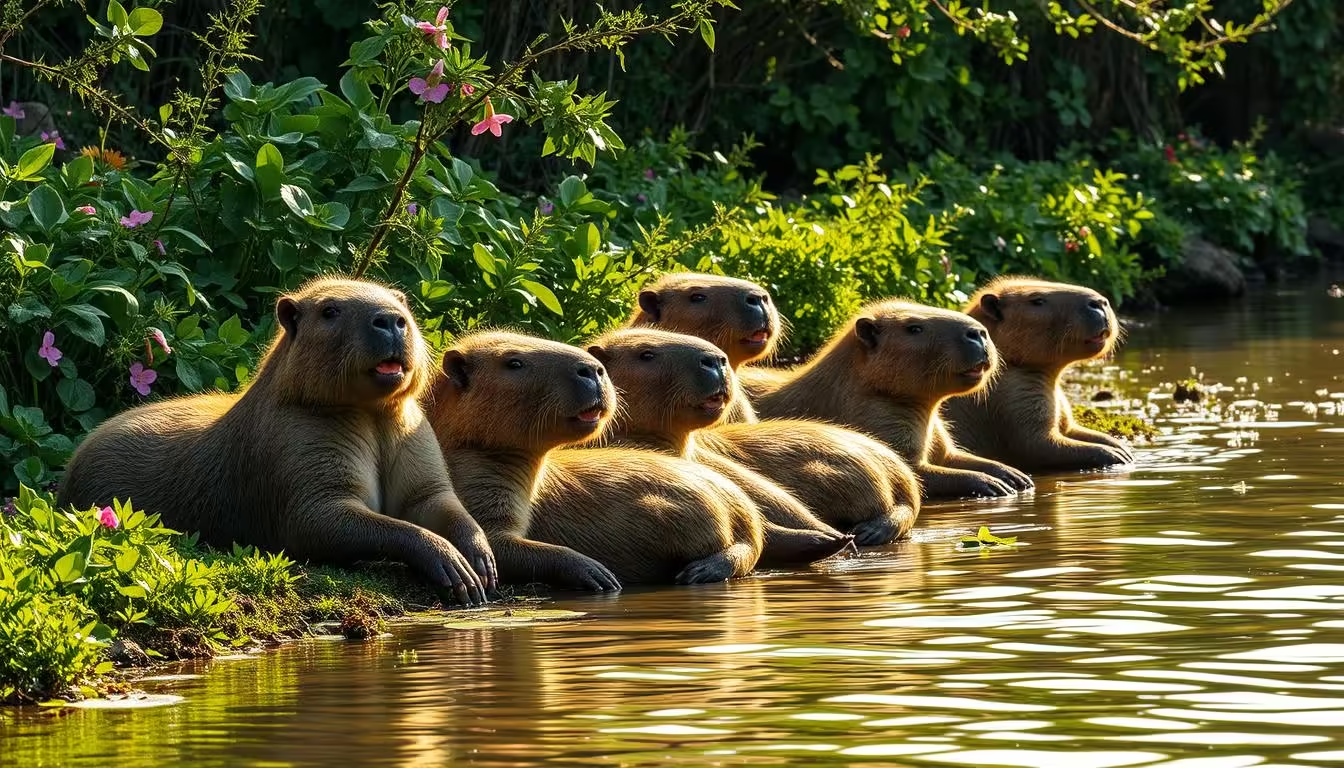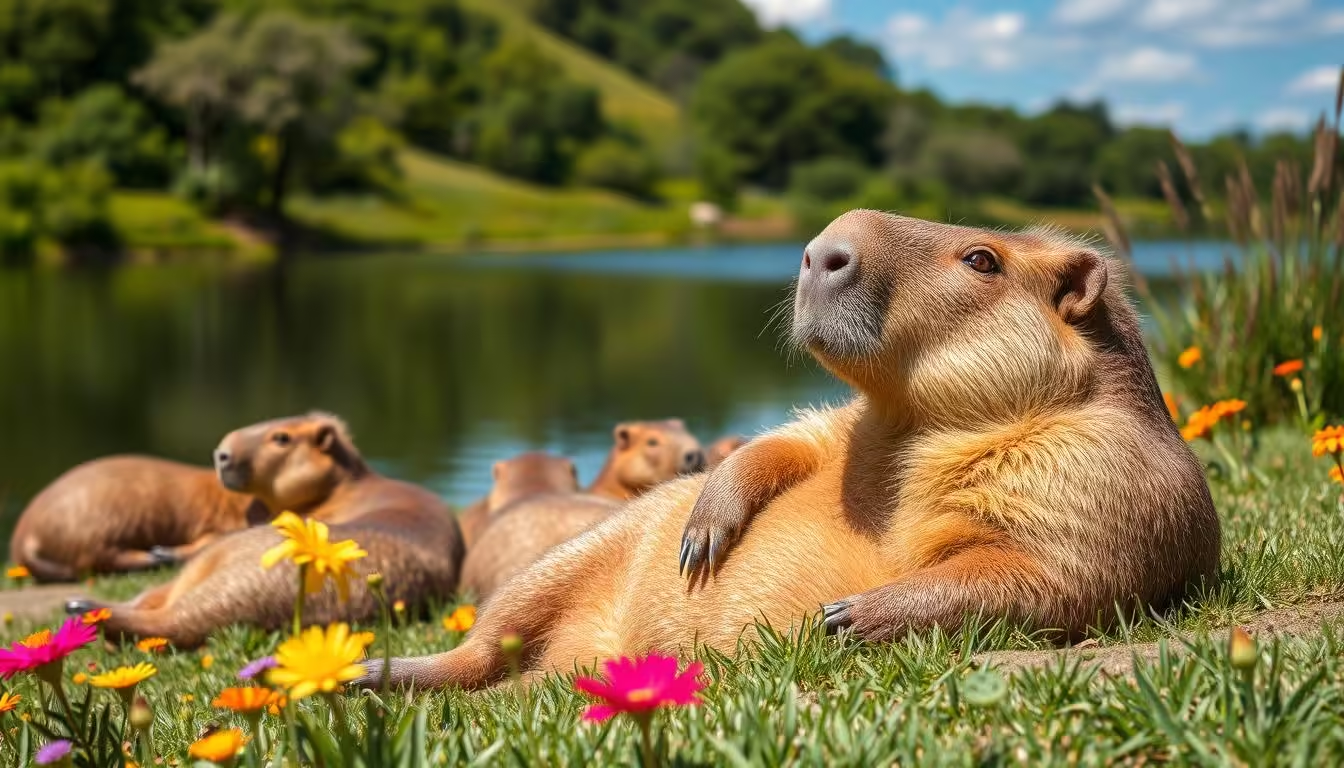Capybaras can live three to ten times longer than their smaller cousins. This makes them very interesting to scientists and the public.
The secrets to their long lives include their unique genetics and how they adapt to their environment. Their social structure also plays a big role. These factors help us understand why capybaras live so long.
Key Takeaways
- Capybaras exhibit remarkable longevity compared to other rodent species, with lifespans up to 10 times longer.
- Genetic, metabolic, and environmental factors all contribute to the exceptional lifespan of capybaras.
- Some capybaras have been documented as living significantly longer than the average for their species, prompting scientific interest.
- Understanding the mechanisms behind capybara longevity may provide insights into aging processes in other mammals.
- Capybara’s social structure and adaptations may play a role in their extended lifespans.
Understanding Capybara Longevity in the Animal Kingdom
Capybaras live longer than many other rodents. In the wild, they live 6 to 10 years. But in captivity, they can live up to 12 years, a 700% increase.
Natural Lifespan Range in Wild vs Captivity
Adult capybaras in the wild weigh 40 to 50 kg. In captivity, they weigh 50 to 60 kg. Capybaras in different places also vary in size.
Comparison with Other Rodent Species
Capybaras live longer than most rodents. For example, mice and rats live 2-3 years. But capybaras can live up to 12 years, thanks to their size and metabolism.
Age Milestones and Life Stages
Capybaras go through different life stages. They become sexually mature at 15 months in care facilities. They live in groups of ten, growing larger in the dry season.
“Capybaras are known to be very intelligent animals, capable of problem-solving and conceptualizing solutions.”
The Evolutionary Marvel of Capybara Genetics
Capybaras, the world’s largest rodents, have evolved remarkable genetic traits. These traits help them live longer. Like elephants, they have extra copies of genes like p53 and LIF. These genes help remove damaged cells.
This genetic adaptation helps capybaras avoid cancer risks. It’s because they have more cells to divide as they grow bigger.
The capybara’s journey has given them a unique genetic makeup. This sets them apart from other rodents. Their size and longevity are thanks to their genes.
Researchers found that capybara longevity genes keep their cells healthy. This reduces the risk of diseases like cancer. With more copies of these genes, capybaras live longer than smaller rodents.
“The capybara’s genetic adaptations are a true testament to the power of evolution. These animals have unlocked the secrets to longevity, and we can learn a great deal from their remarkable genetic makeup.”
Exploring capybara evolutionary adaptations reveals a fascinating story. Their genetic resilience ensures they live long. It also helps us understand how genetics, size, and lifespan interact in animals.
How Some Capybaras Live Longer Than Average: Stories of Long-Lived Capybaras
Most capybaras in the wild live about 4 years because of predators. But, some capybaras live much longer. In safe places, like zoos, some capybaras can live up to 12 years. These stories help us understand why some capybaras live longer than others.
Notable Cases of Extended Lifespans
Clarence, a capybara at the Brookfield Zoo in Illinois, lived for 16 years. This is much longer than most capybaras live. Scientists studied Clarence to learn why he lived so long.
Record-Breaking Capybaras
Henrietta, a capybara at the Bronx Zoo in New York, lived to be 20 years old. This is the longest recorded age for a capybara. Her long life amazed everyone, and scientists are still studying her.
Scientific Documentation of Longevity Cases
Researchers and zookeepers have documented these long-lived capybaras. They have studied their health, behavior, and environment. This helps scientists understand why some capybaras live longer than others.
The Role of Metabolism in Capybara Aging
Capybaras, the world’s largest rodents, have a long lifespan. Their metabolism plays a big role in this. They might have a slower metabolism than smaller rodents.
This slower metabolism could help them age better. Studies show that a lower metabolic rate means less damage to DNA. This damage is a big part of aging.
The capybara genome shows gene-family expansions that help them live longer. These genes help fight cancer and add to their longevity. This genetic insight is fascinating.
“The capybara genome-wide ratio of nonsynonymous to synonymous mutations (ω) is elevated relative to other rodents, indicating potential adaptive evolution of their genome.”
Studying capybara metabolism and aging can teach us a lot. It might even help us understand how to live longer. This research could lead to new ways to improve human health and longevity.
Environmental Factors Influencing Capybara Lifespan
The quality of a capybara’s habitat is key to its lifespan. Things like food, predators, and stress can affect how long they live. Also, the climate matters a lot, as capybaras need certain temperatures and humidity to thrive.
Habitat Quality Impact
Capybaras in good habitats live longer than those in bad ones. They need a rich diet and no big predators to live a long life. But, bad habitats with less food or more predators can cut their lives short.
Climate Considerations
Capybaras love tropical and subtropical places with mild weather and high humidity. But, extreme weather like long droughts or cold can harm them. This can shorten their lives.
Human Interaction Effects
Humans can help or hurt capybara lifespans. Things like destroying their homes, hunting, or taking too many resources can hurt them. But, protecting their homes and creating safe places can help them live longer.
“The fate of capybaras is inextricably linked to the health of their environment. Preserving and restoring their natural habitats is crucial to ensuring the longevity of these fascinating creatures.”
Dietary Secrets of Long-Living Capybaras
Capybaras live long because of their special diet. They eat a lot of plants like grasses, fruits, and veggies. This diet gives them important nutrients and antioxidants that help them age well.
They eat in a way that helps them not get too fat. This is like a diet that helps other animals live longer. Also, what they eat can change how long they live, depending on where they are.
Capybaras eat about 5-8% of their body weight every day. They spend half their day looking for food, especially in the morning and late afternoon. This helps them stay healthy and big.
“Capybaras are herbivores and eat a diet of aquatic plants, grasses, barks, tubers, and sugar cane. They drink milk for the first 16 weeks of their lives.”
But there’s more to capybaras’ long lives than just what they eat. They do well on plants, picky eating, and efficient metabolism. Learning about their diet helps us understand how they live so long.
Social Structure and Its Impact on Longevity
Capybaras, the world’s largest rodents, live in groups of up to 100 individuals. Their capybara social structure likely helps them live longer. This structure brings many health benefits.
Group Living Benefits
Being part of a large group has many perks for capybaras. The group’s watchfulness keeps them safe from predators. This reduces the chance of getting hurt or dying.
Also, group living means they can share food and water. This makes sure everyone gets what they need to survive.
Stress Reduction Through Social Bonds
Strong bonds within the group are key to stress reduction. Capybaras help each other and make decisions together. This creates a sense of safety and belonging.
This feeling of security lowers stress levels. High stress can harm health over time. By managing stress, capybaras can stay healthy and live longer.
Their social support and friendship are crucial. They help capybaras live longer than many other rodents.
“The social structure of capybaras is a remarkable evolutionary adaptation that has contributed to their exceptional longevity, showcasing the power of cooperative living and strong social bonds.”
Physical Adaptations Contributing to Longevity
Capybaras, the world’s largest rodents, have evolved remarkable physical adaptations. These adaptations may contribute to their impressive longevity. Their substantial size offers them protection against predators and environmental stressors. This is something smaller rodents do not have.
Their semi-aquatic lifestyle is another striking adaptation. They can efficiently regulate their body temperature by alternating between land and water. This helps them manage physiological stress, potentially extending their lifespan. Their robust immune system, developed for their social and aquatic environments, also plays a crucial role. It helps them resist age-related diseases.
| Adaptation | Potential Longevity Benefit |
|---|---|
| Large Body Size | Protection from predators and environmental stressors |
| Semi-Aquatic Lifestyle | Efficient temperature regulation, reduced physiological stress |
| Robust Immune System | Resistance to age-related diseases and conditions |
These physical adaptations, along with their evolutionary traits, contribute to their remarkable longevity. They allow capybaras to thrive in their natural habitats. They can live for up to 15 years, an impressive lifespan for a rodent of their size.
Health Management and Disease Resistance
Capybaras have a strong immune system, thanks to their semi-aquatic and social lifestyle. This immunity helps them live longer by fighting off diseases and aging issues. But, like all animals, they can still get sick as they age.
Natural Immune System Strengths
The author has spent over 12 years with capybaras, learning about their health. They’ve seen how capybaras resist diseases well. Their immune system adapts to the pathogens they meet in their natural habitats and social life.
Common Age-Related Conditions
Even though capybaras live long, they face health issues as they get older. Senior capybaras might deal with dental problems, arthritis, and organ decline. It’s important to know these issues to care for them well.
Good diet, clean living spaces, and vet visits are key to their health. These steps help keep them healthy for a long time.



